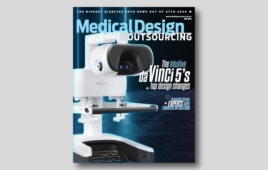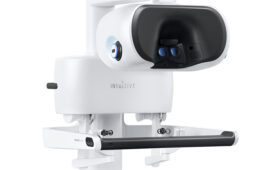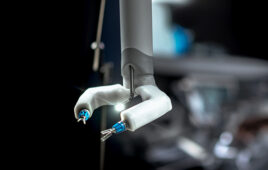Medical robots and robotic devices bring complex challenges to the table. It is important to be prepared to address these challenges to bring a product to market.
Bill Stearns, Intertek

(Image courtesy of the U.S. Navy)
Medical robots are complex, with lots of pieces and components: base stations, robotic arms, sophisticated software, instruments and integrated support equipment. These robotic subsystems are often designed and assembled by multiple teams — i.e., software, hardware, medical professionals, integration and regulatory teams. These teams can be siloed within a company or spread out geographically. Subsystems or parts are frequently subcontracted to other manufacturers.
Medtech manufacturers need to pay greater attention and emphasize coordination to ensure they produce a successful complex device and avoid mistakes. Here are some best practices and ways to prepare for obstacles and overcome them.
Communicate and document
Everyone involved in developing a medical robot must communicate well from the beginning, and those communications must include everyone: designers, engineers, medical experts, programmers, robotics teams, R&D and compliance managers.
Miscommunications and missteps can increase costs and waste time. From the start, manufacturers should establish, share and clarify the goal, expectations, responsibilities, timelines and deadlines to ensure the process is as smooth as possible. A common quality system across all teams is very important for a compliant design and a smooth regulatory approval process. Using a common quality system allows each subsystem to integrate properly into the top-level product design file. Specifically, common risk management, software development and usability processes should be applied across all subsystems.
Using different processes makes system integration increasingly complex, and each different process will need to be evaluated during the regulatory review. This can add unnecessary cost and increase time to market. When subcontracting components or subsystems using a different quality system, the manu
facturer must review, accept and integrate the subsystem design file into the product design file.
Medtech companies should also use common procedures to document and communicate among the different product teams. Using a common quality system will ensure all teams are following and using the same processes, forms and worksheets.
Basic safety, essential performance, hazards and assessments
Medical robots, like other types of medical equipment, fall within the scope of IEC 60601-1, which includes requirements for basic safety and essential performance. Some basic safety requirements include the prevention of shock, fire, excessive temperatures, radiation exposure, mechanical hazards and electromagnetic emissions. Basic safety must be maintained in normal and single-fault conditions. The standard also requires robots to meet the essential performance requirements defined by a manufacturer risk assessment.
Additional requirements for medical robots are defined in the standards IEC80601-2-77 for robotically assisted surgical equipment and IEC80601-2-78 for medical robots used for rehabilitation, assessment compensation or alleviation. Examples of essential performance include information essential to perform surgery, motion control or force/torque of movement. Manufacturer risk management must address all aspects that can contribute to the loss of essential performance, including the breakdown of hardware, software and hazards that relate to usability, including misuse of the system.
Design review
A thorough design review early in the development process can be critical to a product’s success. Typically, a regulatory review is performed after the product design is completed. Major changes at this stage can be difficult to correct, costly and increase the time to market. A proper regulatory design review considers many of the key aspects of a product. They may include a review of the following:
- ISO 14971 risk management process, which can be very complex when a product has multiple subsystems. This should include a review of the checklists required by the regulatory review process.
- Operator and patient isolation issues, which lead to costly re-designs.
- Critical component identification and review for proper ratings and regulatory compliance.
- Identification of all applicable standards and testing that need to be performed. Some robots are used in conjunction with other medical equipment that can affect the robot design. High-frequency surgery and endoscopic equipment are examples that can have a direct impact on the isolation strategy, component selection and testing that will need to be performed.
- A review of the electromagnetic radiation and immunity test plan as required by IEC60601-1-2 is important. This test plan is required to consider all the applicable standards, procedures to monitor essential performance during testing, and the different configurations of the product to be tested. The addition of wireless communication makes this plan more complex.
Performing an early design review helps kick off the regulatory review and can establish important relationships among the design teams and the test lab. Many times, the work performed during the design review can be used during the final regulatory review. In addition, the reviewer will be more familiar with the product and design team and this can lead to a smooth, timely and less expensive regulatory approval process.
As the industry evolves, manufacturers can expect the requirements and expectations around medical robotics to change as well. It is important to stay informed of new standards, new technology, industry demands and trends to adapt existing products, change products in development and create new technologies. Working with trusted vendors and paving the way for communication within your company will help guide devices from concept to production to market, helping ensure product success.
Bill Stearns is a senior engineer on Intertek’s medical device team, serving as team lead for evaluating medical products for safety and performance. He has more than 30 years of electrical engineering experience, with more than a decade focused on regulatory and compliance needs.
The opinions expressed in this blog post are the author’s only and do not necessarily reflect those of Medical Design and Outsourcing or its employees.




